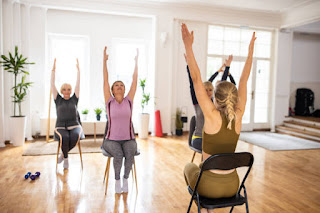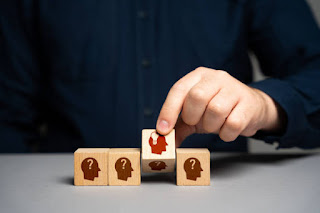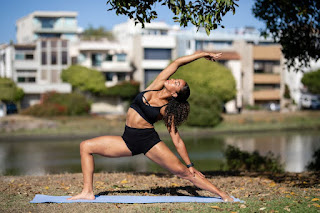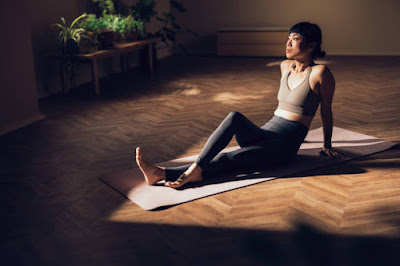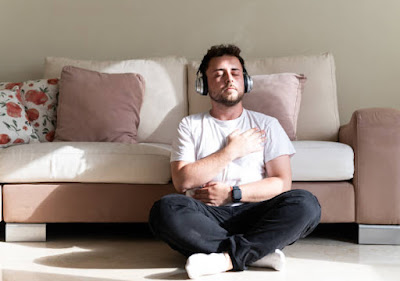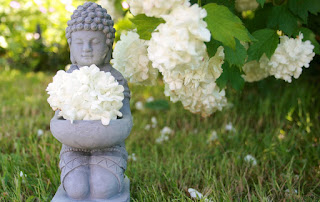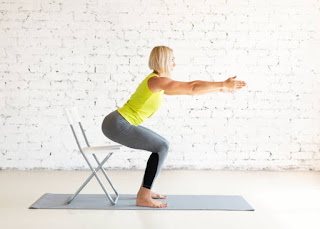Balance and Coordination with Adaptive Yoga: Gentle Practices for All Ages
Balance and Coordination with Adaptive Yoga: Gentle Practices for All Ages
Maintaining balance and coordination is crucial for overall health and well-being, especially as we age. Good balance not only prevents falls but also improves posture, stability, and confidence in everyday movements. While many associate balance exercises with standing positions or vigorous activities, adaptive yoga offers a gentle, accessible way for people of all ages to improve balance and coordination.
In this article, we will explore yoga poses that focus specifically on balance and coordination. These practices can be done by people with limited mobility, beginners, or anyone looking for a gentle yet effective way to enhance their body’s stability.
Why Balance and Coordination Matter
Balance is the ability to maintain your body’s center of gravity over its base of support, while coordination refers to the smooth and efficient movement of different parts of your body. Both are essential for everything from walking and climbing stairs to bending down and reaching for objects.
As we age, balance and coordination naturally decline, but yoga can help strengthen the muscles and sharpen the mind-body connection required for maintaining these abilities.
Adaptive Yoga Poses for Balance and Coordination
The following chair yoga poses are designed to enhance balance and coordination by engaging both your body and mind. Each pose includes detailed instructions to guide you into the posture, along with a mental picture to help you visualize and feel the movement.
Seated Eagle Arms (Garudasana Arms)
How to Perform:
- Sit tall in your chair with both feet flat on the floor.
- Extend your arms in front of you at shoulder height.
- Cross your right arm over your left at the elbows and bring your palms toward each other (or as close as they can comfortably go).
- Lift your elbows slightly and press your forearms away from your face.
- Hold for 3-4 breaths, then switch sides by crossing your left arm over your right.
Mental Picture:
Visualize the elegance of an eagle with wings outstretched, crossing one over the other. Feel the stretch in your shoulders and upper back as you maintain focus on your alignment. Your upper body feels lifted and supported as your arms entwine gracefully.
Why It Works:
Eagle arms improve coordination by encouraging the arms to move in a controlled and synchronized way. It also stretches the shoulders and upper back, promoting better posture, which is essential for balance.
Seated Star Pose (Utthita Tadasana Variation)
How to Perform:
- Sit near the edge of your chair with feet wide apart and toes pointing outward slightly.
- Inhale as you extend your arms out to the sides, forming a star shape with your body.
- Spread your fingers wide and engage your core as you lift your chest.
- Hold for 3-5 breaths, feeling the stretch through your arms, chest, and legs.
Mental Picture:
Imagine you are a shining star, with energy radiating outward from the center of your body to your fingertips and toes. Feel grounded through your feet, while your arms and chest open wide, creating a sense of expansion and strength.
Why It Works:
Star pose enhances balance and coordination by promoting awareness of the body’s extremities and engaging the core. The wide-legged stance creates a stable base, while the open arms encourage balance between upper and lower body coordination.
Seated Heel Lifts (Calf Raises for Balance)
How to Perform:
- Sit tall with your feet flat on the floor, hip-width apart.
- Rest your hands on your thighs for support.
- Inhale and lift both heels off the floor, rising onto the balls of your feet.
- Hold for a moment, then exhale and slowly lower your heels back down.
- Repeat for 10-12 repetitions, moving slowly and mindfully.
Mental Picture:
Picture yourself gently lifting your heels off the ground, as if you’re preparing to tiptoe through a quiet room. Your legs feel strong and steady as your calves engage to lift you. As your heels return to the floor, feel grounded and balanced.
Why It Works:
Heel lifts strengthen the calf muscles, which are essential for balance and stability. By practicing this movement in a seated position, you improve coordination between your feet and core without the need to stand.
Seated Arm and Leg Lift (Core and Balance Coordination)
How to Perform:
- Sit tall with your feet flat on the floor and your hands resting on your thighs.
- On an inhale, lift your right arm straight in front of you while simultaneously lifting your left foot a few inches off the ground.
- Hold for a breath, focusing on keeping your balance.
- Exhale and lower both the arm and leg back to the starting position.
- Repeat on the other side, lifting your left arm and right foot.
- Continue alternating sides for 8-10 repetitions.
Mental Picture:
Visualize yourself as a stable, grounded tree, lifting one branch and one root at a time. Your core engages to maintain balance as you coordinate the smooth movement of your arm and leg. Feel steady, strong, and focused as your limbs move in harmony.
Why It Works:
This exercise challenges balance and coordination by engaging the core muscles while moving opposite limbs. The cross-body movement strengthens the connection between the left and right sides of the brain, improving overall coordination.
Seated Warrior II Arms (Virabhadrasana II Variation)
How to Perform:
- Sit tall at the edge of your chair with feet wide apart and toes pointing forward.
- Extend your arms out to the sides at shoulder height, palms facing down.
- Turn your head to look over your right hand, engaging your core to keep your torso steady.
- Hold for 3-4 breaths, then switch sides by turning your head to look over your left hand.
Mental Picture:
Picture yourself as a calm, steady warrior, with arms extended in opposite directions like two powerful blades. Your gaze is focused, and your core feels strong, as if nothing can shake your balance. Feel rooted through your hips and energized through your arms.
Why It Works:
Warrior II strengthens the muscles in your arms and core, which are crucial for maintaining balance. By focusing on your gaze and arm alignment, you enhance coordination between the upper body and lower body.
Seated March with Alternating Arms
How to Perform:
- Sit tall with your feet flat on the floor and hands by your sides.
- Lift your right knee toward your chest as you raise your left arm overhead.
- Lower your arm and leg back down, then lift your left knee and right arm.
- Continue alternating sides, mimicking a marching motion for 30-60 seconds.
Mental Picture:
Envision yourself marching in place, your limbs moving in perfect synchronization. As one leg lifts, the opposite arm rises, creating a smooth rhythm. Feel the strength in your legs and the fluidity in your arms as your body moves in harmony.
Why It Works:
This movement helps build coordination between the upper and lower body while improving core stability. The rhythmic motion also enhances balance by engaging multiple muscle groups.
Seated Cactus Arms with Torso Rotation
How to Perform:
- Sit tall with your feet flat on the floor.
- Extend your arms to the sides and bend your elbows at 90 degrees, palms facing forward (cactus arms).
- Inhale to lengthen your spine, then exhale and rotate your torso to the right.
- Inhale back to center, then exhale and rotate to the left.
- Repeat for 6-8 rotations on each side.
Mental Picture:
Picture yourself as a cactus, with sturdy arms extended like branches, rooted in the desert. As you gently twist from side to side, your spine feels long and supported, and your arms remain strong and steady.
Why It Works:
This pose improves balance and coordination by engaging the core and upper body in a rotational movement. The twist helps improve spinal mobility and balance, while cactus arms strengthen the shoulders and promote better posture.
Tips for Adapting Your Practice
Adaptive yoga allows for endless modifications to ensure that every pose feels comfortable and accessible. Here are some tips to make your practice work for you:
- Use Props: Place a yoga block or cushion under your feet if they don’t comfortably reach the floor, or use a strap for additional support in certain stretches.
- Reduce Range of Motion: Focus on smaller movements or shorter holds if you feel any discomfort. Yoga is about listening to your body and working within your limits.
- Mind Your Breath: Coordinating movement with your breath can help improve balance and focus. Take deep, controlled breaths to enhance the flow of each pose.
Conclusion
Balance and coordination are fundamental skills that we use in everyday life, from walking to reaching for objects. Adaptive yoga offers a gentle and accessible way to improve these abilities, no matter your age or fitness level. By practicing these poses regularly, you’ll not only enhance your physical balance but also develop a stronger connection between your body and mind.
Remember, balance is as much a mental exercise as it is a physical one. The more you practice these gentle movements, the more attuned you will become to your body’s sense of equilibrium and coordination.
So, take a seat, get comfortable, and begin your journey to better balance and coordination with adaptive yoga.
Explore More on Adaptive Yoga
As you work through this series, I encourage you to explore some of my other articles on yoga, which dive deeper into adaptive practices and the benefits of chair and restorative yoga:
- A beginners guide to Adaptable Chair Yoga
- Yoga therapy for Mobility and Rehabilitation: how to use chair yoga
- The Essentials of Restorative Yoga: Poses, Props, and Practices
- Integrating Strength, Flexibility, and Balance: Adaptive Yoga Flow
- Balance and Coordination with Adaptive Yoga: Gentle Practices for All Ages
- Flexibility and Range of Motion: Chair Yoga for Limited Mobility
- Core Strength and Stability: Adaptive Chair Yoga for Beginners
- Breath Awareness and Mindful Movement
- 6-Week Adaptive Yoga Course: Build Strength, Flexibility, and Balance
